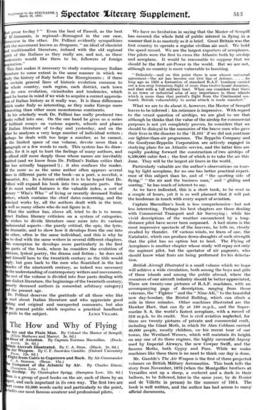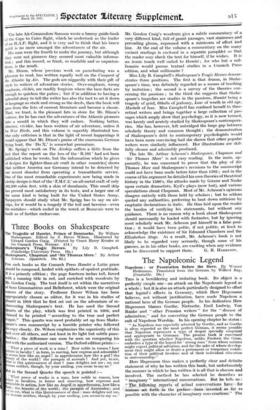The How and Why of Flying . •
e Air and the Plain Man. By Colonel the Master of Sempill.' (Elkin Mathews and Marrot. 35. 6d.) • e Airship. By Christopher Sprigg. (Sampson Low. 12s. 6d.)
RE is a group of good books on the air, each of them by an Pert, and each important in its own way. The first two are Olt (some 85,000 words each) and particularly to the point, befits our most famous amateur and professional pilots. • We have no hesitation in saying that the Master of Sempill has- covered, the Whale field of public interest 'in _ flying in s
manner that is as masterly as it is brief. Great Britain was the first country to operate a regular civiliansitanail. We hold the speed record. We are the largest exporters of aeroplanes. Our pilots were the first to cross the Atlantic both by airship and aeroplane. It would be reasonable to suppose that we should be the first air-Power in the world. But we are not, although no country is more vulnerable to bombing.
"Definitely—and on this point there is now almost universal agreement—the air has become our first line of defence. . . . As long ago as 1926 a formation of standard R.A.F. bombers carried out a non-stop formation flight of more than twelve hours', duration, and that with a full military load. When one considers that there is no town or industrial area of any importance in these islands which is more than that period's flight from the Continental sea- board, British vulnerability to aerial attack is made manifest."
What we are to do about it, however, the Master of Sempill leaves to be inferred : his reticence is impressive. With regard to the vexed question of airships, we are glad to see that although he thinks that the value of the airship for commercial purposes is not yet completely proven, he considers that we should be disloyal to the memories of the brave men who gave their lives in the disaster.to the 'R.101' if we did not pontinue our lighter-than-air programme. The Zeppelin Company and the Goodyear-Zeppelin Corporation arc actively engaged in studying plans for an Atlantic service, and the latter firm are rapidly pushing forward the construction of two airships of 6,500,000 cubic feet-; the first of which is -to take the air this June. They will be the largest air liners in the world., Particularly valuable are the author's observations on tour- ing by light aeroplane, for no one has better praetical experi- ence of this subject than he, and of "the sporting side of flying," "the air and the business man," and "gliding and soaring," he has much of interest to say.
As we have indicated, this is a short book, to -be read in a 'couple of hours, yet it is so well planned that it will put the landsman in touch With every aspect of aviation.
Captain Macmillan's book is less comprehensive—but not less interesting. Perhaps his best chapters are those dealing with Commercial Transport and Air Surveying ; while his vivid descriptions of the weather encountered by a long- distance pilot have never been surpassed. A hail storm is the most impressive spectacle of the heavens, he tells us, closely rivalled by thunder. Of various winds, we learn of one, the Katabatic, which can produce down-draughts of such strength that the pilot has no option but to land. The Flying of Aeroplanes is another chapter whose study will repay not only the aspirant pilot, but the spectator of air pageants, who should know what feats are being performed for his delecta- tion.
British Aircraft Illustrated is a small volume which We hope will achieve a wide circulation, both- among the boys and girls of these islands and among the public abroad, where the
resources of our aircraft industry should be better-appreciated, There are twenty-one pictures of R.A.F. machines, with an accompanying page of description, ranging from those veterans, the " Fighter" and the " Nine-AK," to the beautiful new day-bomber, the Bristol Bulldog, which can climb a mile in three minutes. Other machines illustrated are the
Hawker Hart, that can fly at 180 m.p.h., and the Super- marine S. 6, the world's fastest aeroplane, with a record of 319 m.p.h. to its credit. Nor is civil aviation neglected, for there are twenty pictures of -private and commercial craft,
including the Giant Moth, in which Sir Alan .Cobham carried 40,000 people, mostly children,- on- his recent tour of our towns, the Westland Wessex, which will maintain its height an any one of its three engines, the highly successful Argosy used by Imperial Airways, the new Cowper Swift, and the famous Moths, both Gypsy and Puss. While we make machines like these there is no need to think our day is done.
Mr. Gamble's The jrA Weapon is the first of three projected volumes on British Military Aeronautics. This book tells the story from November, 1878 (when the MontgoMer brothers at Versailles sent up a sheep, a cockerel and a duck in their balloon, to be followed, later in the same year, by de Rozier and de Villette in person) to the summer of 1914. The book is well written, and the author has had access to many official documents. The late Air-Commodore Samson wrote a breezy guide-book of the Cape to Cairo flight, which he undertook as the leader (,f an R.A.F. flight, and it is very sad to think that his brave spirit is no more amongst the adventurers of the air. His men were the fourth to Make the journey, but although they were not pioneers they secured most valuable informa- tion; and this record, so frank, so readable and so unpreten- tious, is the result. Mr. Dixon, whose previous work on parachuting was a pleasure to read, has .written equally well on the Conquest of the Atlantic by Air. The gods are niggardly with their gift of style to writers of adventure stories. Over-emphasis, wrong emphasis, clichés, are readily forgiven where the bare facts are enough to quicken the pulses ; but if in addition to having a splendid story to tell the writer has also the tact to set it down in language as stark and strong as the deeds, then the book will pass from the lists of current literature and become a classic. That, we trust, is the pleasant fate in store for Mr. Dixon's volume, for he has cast the adventures of the Atlantic pioneers into a mould in which they will endure. Nothing better, directer, vivider, has been written of air adventure, unless it he War Birds, and this volume is superbly illustrated too. Our only criticism is that in the light of recent happenings it would appear that Mr. Dixon's praise of the enormous German flying boat, the Do X,' is somewhat premature.
Mr. Sprigg's work on The Airship suffers a little from the fact that the report on the loss of the R.101 ' had not been published when he wrote, but the information which he gives of designs for lighter-than-air craft in other countries) shows that neither America nor Germany intend to be deterred by our recent disaster from operating a transatlantic service. One of the most remarkable experiments now being made in airship design is that of the Z.M.C.2,' an all-metal craft of only 202,200 cubic feet, with a skin of duralumin. This small 'ship has proved most satisfactory in its tests, and a larger one of the same kind is being built for the United States Army. Taxpayers should study what Mr. Sprigg has to say on air- ships, for it would be a tragedy if the toil and heroism—even the mistakes—which ended in the wreck at Beauvais were to baulk us of further endeavour.















































 Previous page
Previous page